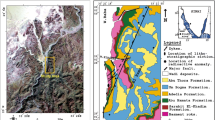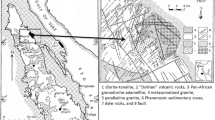Abstract
The present work aims to integrating detailed geologic field studies with natural radionuclides activity ratios as a tool for studying uranium-mobility in three rock types at El Sela shear zone, southeastern Desert, Egypt. Natural radionuclides content have been measured by γ-ray spectrometry employing a shielded HPGe detector. This study revealed that 238U and some of its progenies were redistributed after the rock emplacements and subjections to several alteration processes. The acidic and alkaline alterations play their role in the redistribution of radionuclides in different rock types. The main alteration processes are the argillization, fluoritization, silicification and ferrugination with formation of visible U-mineralization.










Similar content being viewed by others
References
Turhan Ş (2012) Estimation of possible radiological hazards from natural radioactivity in commercially-utilized ornamental and countertops granite tiles. Ann Nucl Energy 44:34–39
Lahaye C, Guibert P, Bechtel F (2012) Uranium series disequilibrium detection and annual dose determination: a case study on Magdalenian ferruginous heated sandstones (La Honteyre, France). Radiat Meas 47:1–4
Lee SY, Kim SJ, Baik MH (2008) Chemical weathering of granite under acid rainfall environment, Korea. Environ Geol 55:853–862
Goldich SS (1938) A study in rock weathering. J Geol 46:17–58
Bonotto DM, Andrews JN, Darbyshire DPF (2001) A laboratory study of the transfer of 234U and 238U during water–rock interactions in the Carnmenellis granite (Cornwall, England) and implications for the interpretation of field data. Appl Radiat Isot 54:977–994
Ibrahim ME, Zalata AA, Assaf HS, Ibrahim IH, Rashed MA (2005) El Sella shear zone, South Eastern Desert, Egypt. Example of vein-type uranium deposit. In: The 9th international mining, petroleum and metallurgical engineering conference, pp 41–55
Ibrahim TM, Amer TE, Ali KG, Omar SA (2007) Uranium Potentiality and its extraction from El Sela shear zone, south Eastern Desert Egypt. Fac Sci Minufia Univ XXI:1–18
Ali KG (2011) Structural control of El Sela granites and associated uranium deposits, south Eastern Desert. Arab J Geosci, Egypt. doi:10.1007/s12517-011-0489-y
Ramadan TM, Ibrahim TM, Said A, Baiumi MB (2013) Application of remote sensing in exploration for uranium mineralization in Gabal El Sela area, south Eastern Desert, Egypt. J Remote Sens Space Sci 16:199–210
Abdel Gawad AE, Orabi AH, Bayoumi MB (2014) Uranium evaluation and its recovery from microgranite dike at G. El Sela area, South Eastern Desert, Egypt. Arab J Geosci. doi:10.1007/s12517-014-1499-3
Gaafer I, Cuney M, Abdel Gawad AE (2014) Mineral chemistry of two-mica granite rare metals: impact of geophysics on the distribution of uranium mineralization at El Sela shear zone, Egypt. Open J Geol 4:137–160. doi:10.4236/ojg.2014.44011
Shahin H.A (2014) Zr–Y–Nb–REE mineralization associated with microgranite and basic dykes at EL Sela shear zone, south Eastern Desert, Egypt. SpringerPlus 3:573. http://www.springerplus.com/content/3/1/573
Chinnaesakki S, Bara SV, Sartandel SJ, Tripathi RM, Puranik VD (2012) Performance of HPGe gamma spectrometry system for the measurement of low level radioactivity. J Radioanal Nucl Chem. doi:10.1007/s10967-011-1607-8
Abdi MR, Faghihian H, Mostajaboddavati M, Hasanzadeh A, Kamali M (2006) Distribution of natural radionuclides and hot points in coasts of Hormozgan, Persian Gulf, Iran. J Radioanal Nucl Chem 270:319–324
IAEA International Atomic Energy Agency (1987) Preparation and certification of IAEA gamma spectrometry reference materials, RGU-1, RGTh-1 and RGK-1. Report-IAEA/RL/148
Anjos RM, Veiga R, Soares T, Santos AMA, Aguiar JG, Frascá MHBO, Brage JAP, Uzêda D, Mangia L, Facure A, Mosquera B, Carvalho C, Gomes PRS (2005) Natural radionuclide distribution in Brazilian commercial granites. Radiat Meas 39:245–253
Stoulos S, Manolopoulou M, Papastefanou C (2003) Assessment of natural radiation exposure and radon exhalation from building materials in Greece. J Environ Radioact 69:225–240
Turhan Ş, Gündüz L (2008) Determination of specific activity of 226Ra, 232Th and 40K for assessment of radiation hazards from Turkish pumice samples. J Environ Radioact 99:332–342
Suckow A (2010) Chapter 9: analysis of radionuclides. Radioactivity in the environment 16: 363–406
Pękala M, Kramers JD, Waber HN (2010) 234U/238U activity ratio disequilibrium technique for studying uranium mobility in the Opalinus clay at Mont Terri, Switzerland. Appl Radiat Isot 68:984–992
Sutherland RA, de Jong E (1990) Statistical analysis of gamma-emitting radionuclide concentrations for three fields in southern Saskatchewan, Canada. Health Phys 58:417–428
Yokoyama Y, Falguères C, Sémah F, Jacob T, Grün R (2008) Gamma-ray spectrometric dating of Late Homo Erectus skulls from Ngandong and Sambungmacan, Central Java, Indonesia. J Hum Evol 55:274–277
Yücel H, Solmaz AN, Köse E, Bor D (2010) Methods for spectral interference corrections for direct measurements of 234U and 230Th in materials by gamma-ray spectrometry. Radiat Prot Dosim 138:264–277. doi:10.1093/rpd/ncp239
Ramebäck H, Vesterlund A, Tovedal A, Nygren U, Wallberg L, Holm E, Ekberg C, Skarnemark G (2010) The Jackknife as an approach for uncertainty assessment in gamma spectrometric measurements of uranium isotope ratios. Nucl Instrum Method Phys Res B 268:2535–2538
Simpson JJ, Grün R (1998) Non-destructive gamma spectrometric U-series dating. Quat Geochronol 17:1009–1022
Yücel H, Cetiner MA, Demirel H (1998) Use of the 1001 keV peak of 234mPa daughter of 238U in measurement of uranium concentration by HPGe gamma-ray spectrometry. Nucl Instrum Method Phys Res A 413:74–82
Pöllänen R, Ikäheimonen TK, Klemola S, Vartti VP, Vesterbacka K, Ristonmaa S, Honkamaa T, Sipilä P, Jokelainen I, Kosunen A, Zilliacus R, Kettunen M, Hokkanen M (2003) Characterization of projectiles composed of depleted uranium. J Environ Radioact 64:133–142
Helgeston HC (1974) Chemical interaction of feldspars and aqueous solution in the feldspars. In: Mackenzie WL, Zussman J (eds) Manchester University Press, Manchester, 184–215
Bucanan MS (1982) The geochemistry of some igneous rock series. Geochim Cosmochim Acta 9:101–137
Sweewald JS, Sayfried JW (1990) The effect of temperature on metal mobility in subsea floor hydrothermal systems: constraints from basalt alteration experiments. Earth Planet Sci Lett 101:388–403
Frantz JD, Weisbord A (1974) Infiltration metasomatism in the system K2O–SiO2–Al2O3–H2O–HCl. Geochem Transp Kinet 634:261–271
Gascoyne M, Miller NH, Neymark LA (2002) Uranium-series disequilibrium in tuffs from Yucca Mountain, Nevada, as evidence of pore-fluid flow over the last million years. Appl Geochem 17:781–792
Min M, Peng X, Wang J, Osmond JK (2005) Uranium-series disequilibria as a means to study recent migration of uranium in a sandstone-hosted uranium deposit, NW China. Appl Radiat Isot 63:115–125
Dawood YH (2010) Factors controlling uranium and thorium isotopic composition of the streambed sediments of the River Nile, Egypt. JAKU 21(2):77–103
Chabaux F, Granet M, Pelt E, France-Lanord C, Galy V (2006) 238U–234U–230Th disequilibria and timescale of sedimentary transfers in rivers: clues from the Gangetic plain rivers. J Geochem Explor 88:373–375
Brantley SL, Kubicki JD, White AF (2008) Kinetics of water–rock interaction. Springer Science + Business Media, LLC, New York 833
Levinson AA, Bland CJ, Dean JR (1984) Uranium series disequilibrium in young surficial uranium deposits in southern British Columbia. Can J Earth Sci 21:559–566
Osmond JK, Dabous AA, Dawood YH (1999) Uranium series age and origin of two secondary uranium deposits, central Eastern Desert, Egypt. Econ Geol 94:273–280
Latham AG, Schwarcz HP (1987) On the possibility of determining rates of removal of uranium from crystalline igneous rocks using U-series disequilibria-1: a U-leach model, and its applicability to whole-rock data. Appl Geochem 2:55–65
Dawood YH (2001) Uranium-series disequilibrium dating of secondary uranium ore from the south Eastern Desert of Egypt. Appl Radiat Isot 55:881–887
Osmond JK, Cowart JB, Ivanovich M (1983) Uranium isotopic disequilibrium in groundwater as an indicator of anomalies. Appl Radiat Isot 34:283–308
El Aassy IE, El Galy MM, Nada AA, El Feky MG, Abd El Maksoud TM, Talaat SM, Ibrahim EM (2011) Effect of alteration processes on the distribution of radionuclides in uraniferous sedimentary rocks and their environmental impact, southwestern Sinai, Egypt. J Radioanal Nucl Chem 289:173–184
Thiel K, Vorwerk R, Saager R, Stupp HD (1983) 235U fission tracks and 238U-series disequilibria as a means to study recent mobilization of uranium in Archaean pyretic conglomerates. Earth Planet Sci Lett 65:249–262
Chabaux F, Riotte J, Dequincey O (2003) Uranium-series geochemistry: U–Th–Ra fractionation during weathering and river transport. Rev Miner Geochem 52:533–576
Fujii Y, Nomura M, Onitsuka H, Takeda K (1989) Anomalous isotope fractionation in uranium enrichment process. J Nucl Sci Technol 26:1061–1064
Bigeleisen J (1996) Nuclear size and shape effects in chemical reactions; isotope chemistry of the heavy elements. Am Chem Soc 118:3676–3680
Schauble EA (2006) Equilibrium uranium isotope fractionation by nuclear volume and mass-dependent processes. Eos 87, December Supplement, abs. V21B-0570
Schauble EA (2007) Role of nuclear volume in driving equilibrium stable isotope fractionation of mercury, thallium, and other very heavy elements. Geochim Cosmochim Acta 71:2170–2189
Brennecka GA, Borg LE, Hutcheon ID, Sharp MA, Anbar AD (2010) Natural variations in uranium isotope ratios of uranium ore concentrates: understanding the 238U/235U fractionation mechanism. Earth Planet Sci Lett 291:228–233
Clarke SPJ, Peterman ZE, Heier KS (1966) Abundances in uranium, thorium and potassium. In: Handbook of physical constants, vol 97. Geological Society of America Memoirs, New York, pp 521–541
Acknowledgments
The authors would like to express their gratitude to Prof. Dr Ibrahim El Aassy, Professor in Geology, Vice President of Nuclear Materials Authority of Egypt for reading and revising the manuscript, and for his valuable disscusions and suggestions. They cordially thank the reviewers for their helpful comments and recommendations.
Author information
Authors and Affiliations
Corresponding author
Rights and permissions
About this article
Cite this article
Abdel Gawad, A.E., Ibrahim, E.M. Activity ratios as a tool for studying uranium mobility at El Sela shear zone, southeastern Desert, Egypt. J Radioanal Nucl Chem 308, 129–142 (2016). https://doi.org/10.1007/s10967-015-4374-0
Received:
Published:
Issue Date:
DOI: https://doi.org/10.1007/s10967-015-4374-0




